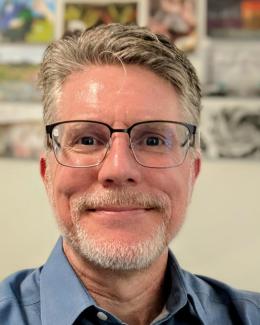The summertime temperatures in the North Slope and Seward Peninsula of Alaska rarely reach higher than 50 degrees F and the perpetually dark winters fall below minus 20 F. It is a brutal environment for any researcher studying the Arctic ecosystem, much less a supercomputer modeler who should be inside writing simulation code for the Titan supercomputer, not probing permafrost patterns on the tundra.
Yet that is exactly what Peter Thornton does.
Thornton is the leader of the Terrestrial Systems Modeling group in the Environmental Sciences Division at the Department of Energy’s Oak Ridge National Laboratory. He is also the head of modeling for the Arctic team of the DOE’s Next-Generation Ecosystem Experiments, which has brought him to Alaska several times to study the effects of climate change up-close, most recently this past July.
“It is one of the few places I’ve been where, as a person, you can feel like a total outsider,” Thornton said. “It’s easy to feel like you’re a very insignificant part of what’s happening in this landscape that is so big and so sparsely populated.”
The inscrutable nature of the Arctic makes it vital to get boots on the ground and experience the ecosystem, he said, to try to understand how this vast region is not the barren wasteland many would imagine, but instead a dynamic, living environment constantly in flux.
Thornton, an avid outdoorsman, enjoys hiking, camping and skiing with his family, so fieldwork appeals to him while fulfilling his scientific curiosity. He first conducted fieldwork in college at Johns Hopkins University. Though he was studying biomedical engineering at the time, he took classes in geography and geology and joined an ecology summer field camp in the Rocky Mountains.
He enjoyed the environmental modeling aspect, so he stayed on at Johns Hopkins for his master’s degree in geography and environmental engineering, studying sediment samples from Chesapeake Bay tidal marshes. He completed his doctorate in terrestrial biogeochemistry at the University of Montana, then worked on climate models for the National Center for Atmospheric Research before joining ORNL in 2008.
As a member of the NGEE Arctic project, Thornton is responsible for integrating the work of the field experimental groups, providing information about what the models need and what can actually be measured. In the field he joins up with the study teams, getting his hands dirty by gauging permafrost depths, measuring shrubs and digging up roots.
“I could do my work from here and never go into the field, but it’s much more effective, in my view, if everybody from the modeling side has firsthand experience of what it is we’re trying to represent,” Thornton said. “It was critical for me to know if what we’re doing is off-the-charts unreasonable or reflects reality.”
Another benefit of fieldwork is the highly collaborative atmosphere that provides a sounding board for ideas and strategies to benefit future models.
“There’s constant interaction with the team, which is something you don’t get with a one-hour meeting or a teleconference,” he said. “It’s an opportunity to explore the science questions in depth and understand where are the limits of knowledge. The attention to detail and planning that goes into a successful field campaign is really impressive and inspiring.
“Our challenge is to understand how what we learn in Barrow and the Seward Peninsula can inform a broader understanding across the North American Arctic or Pan-Arctic region around the world,” Thornton said.
The Oak Ridge Leadership Computing Facility, a DOE Office of Science User Facility, is home of the Titan supercomputer. ORNL is managed by UT-Battelle for the Department of Energy's Office of Science, the single largest supporter of basic research in the physical sciences in the United States. DOE’s Office of Science is working to address some of the most pressing challenges of our time. For more information, please visit energy.gov/science.



